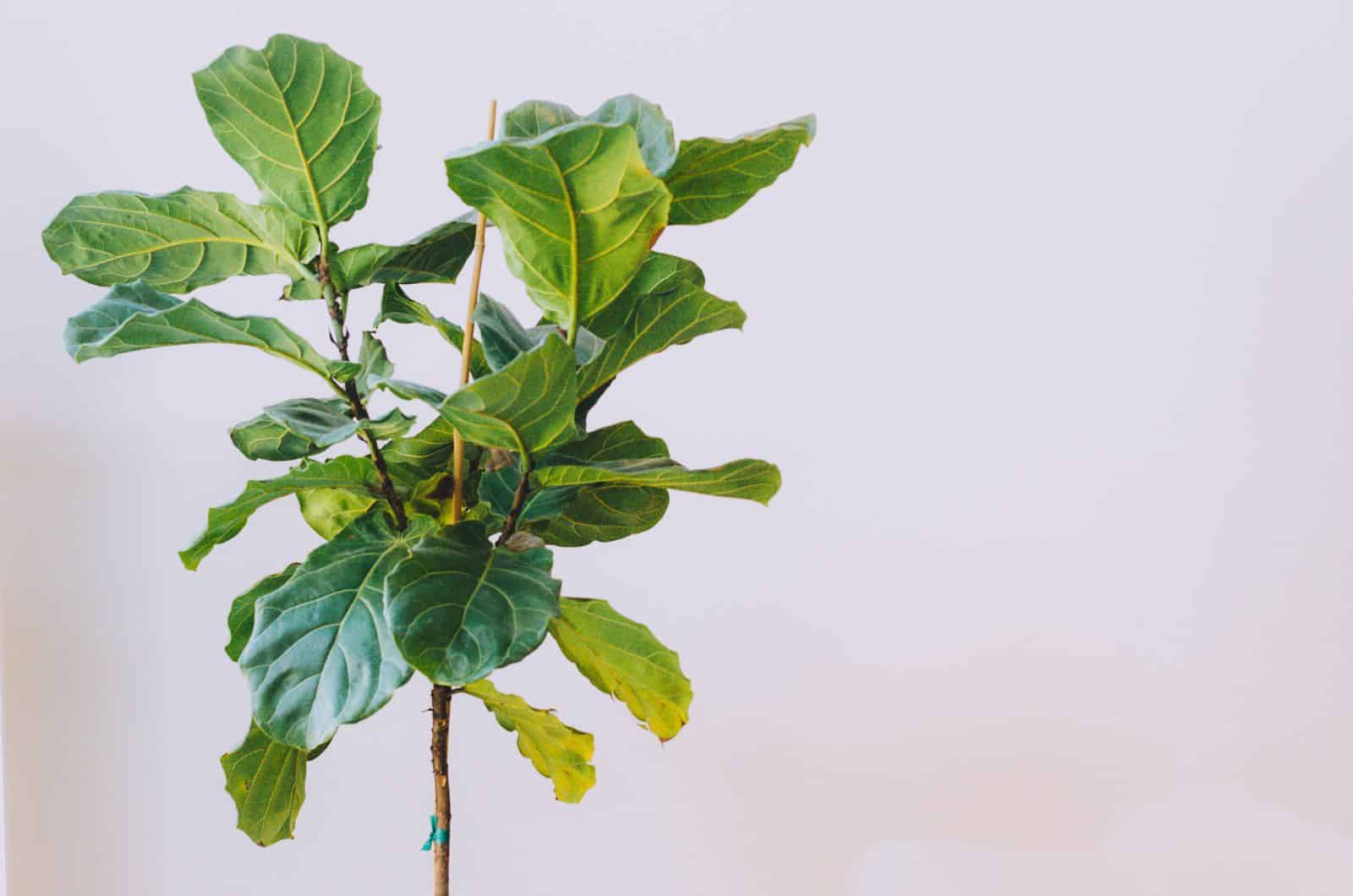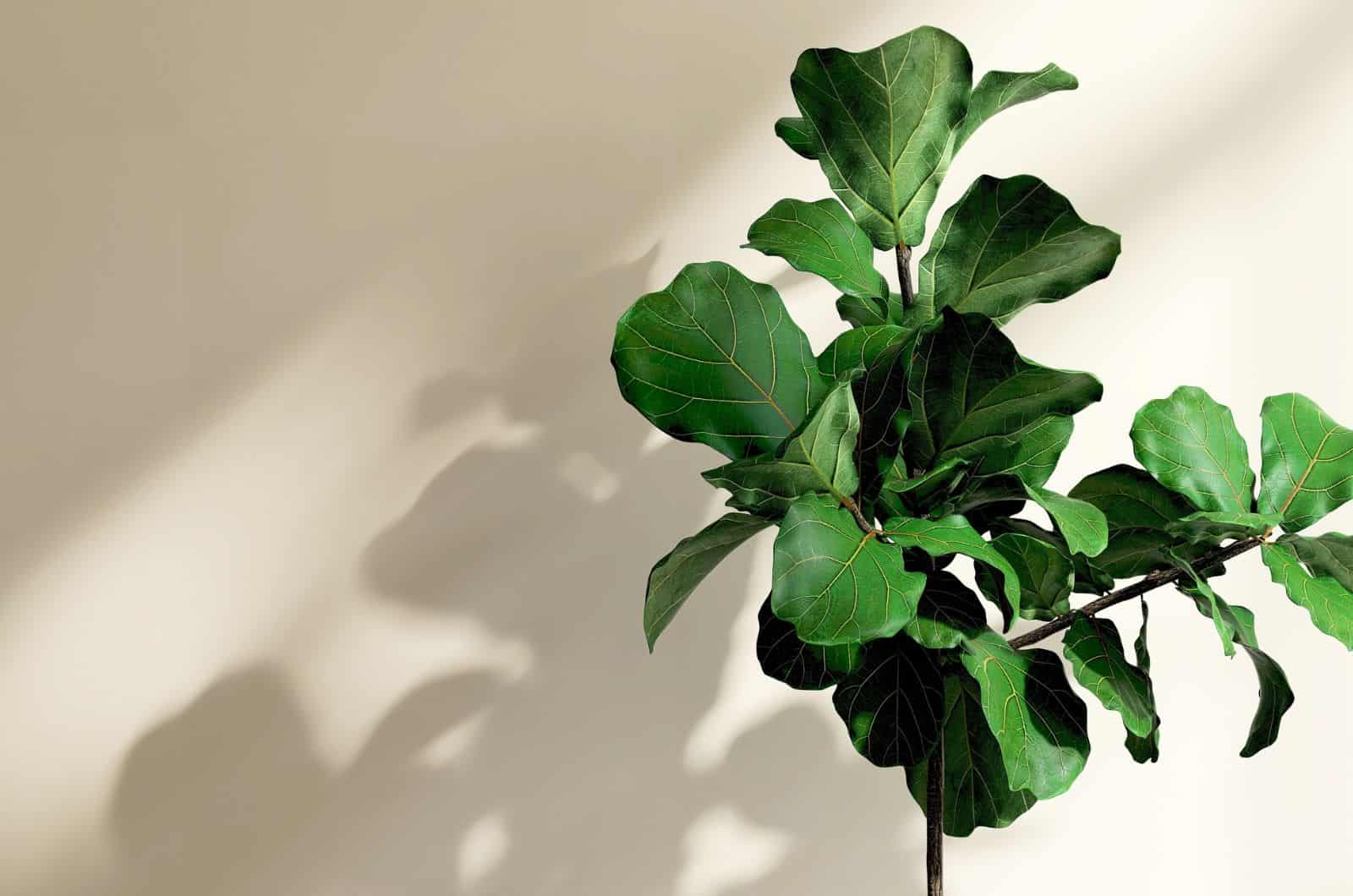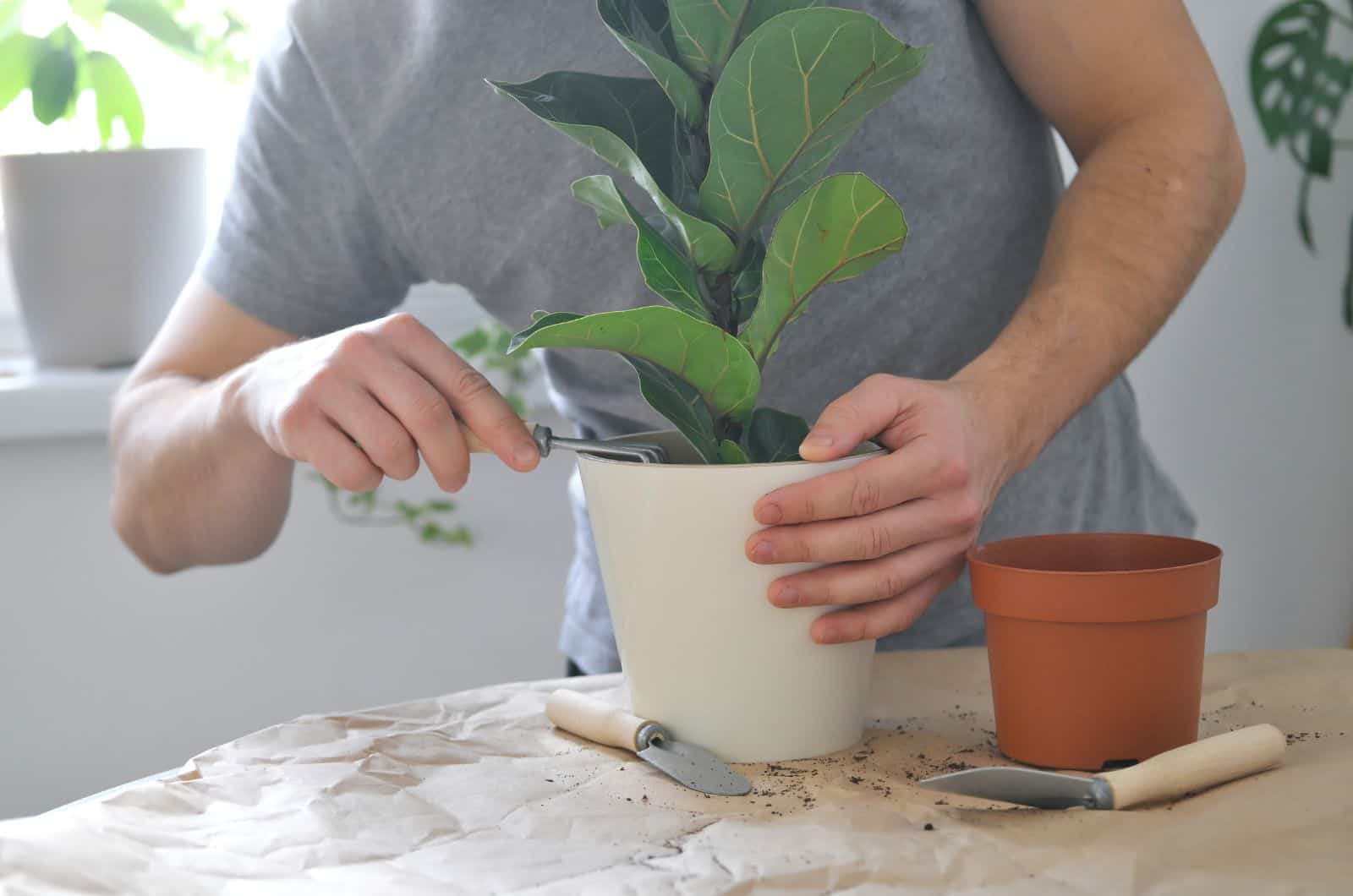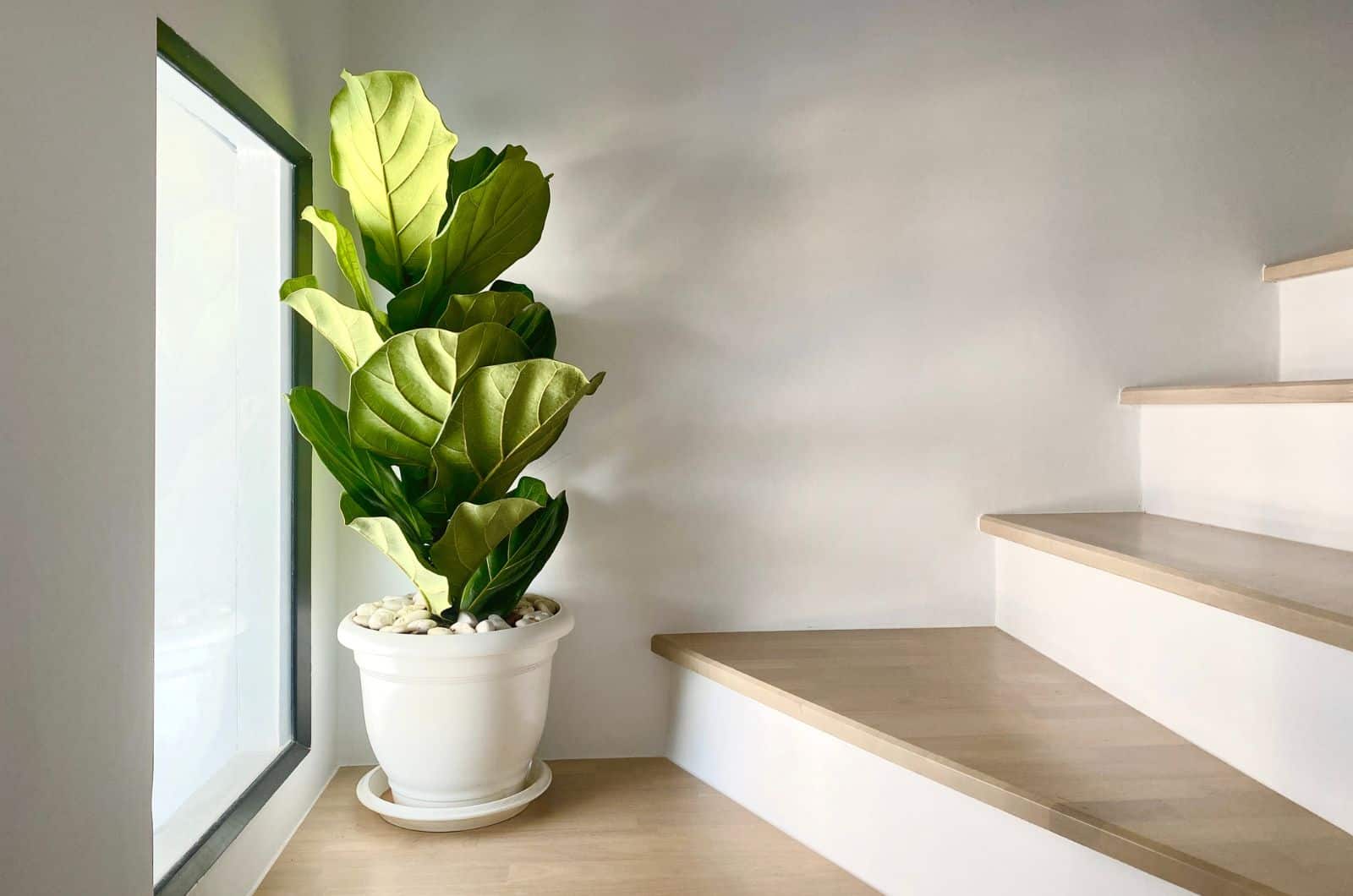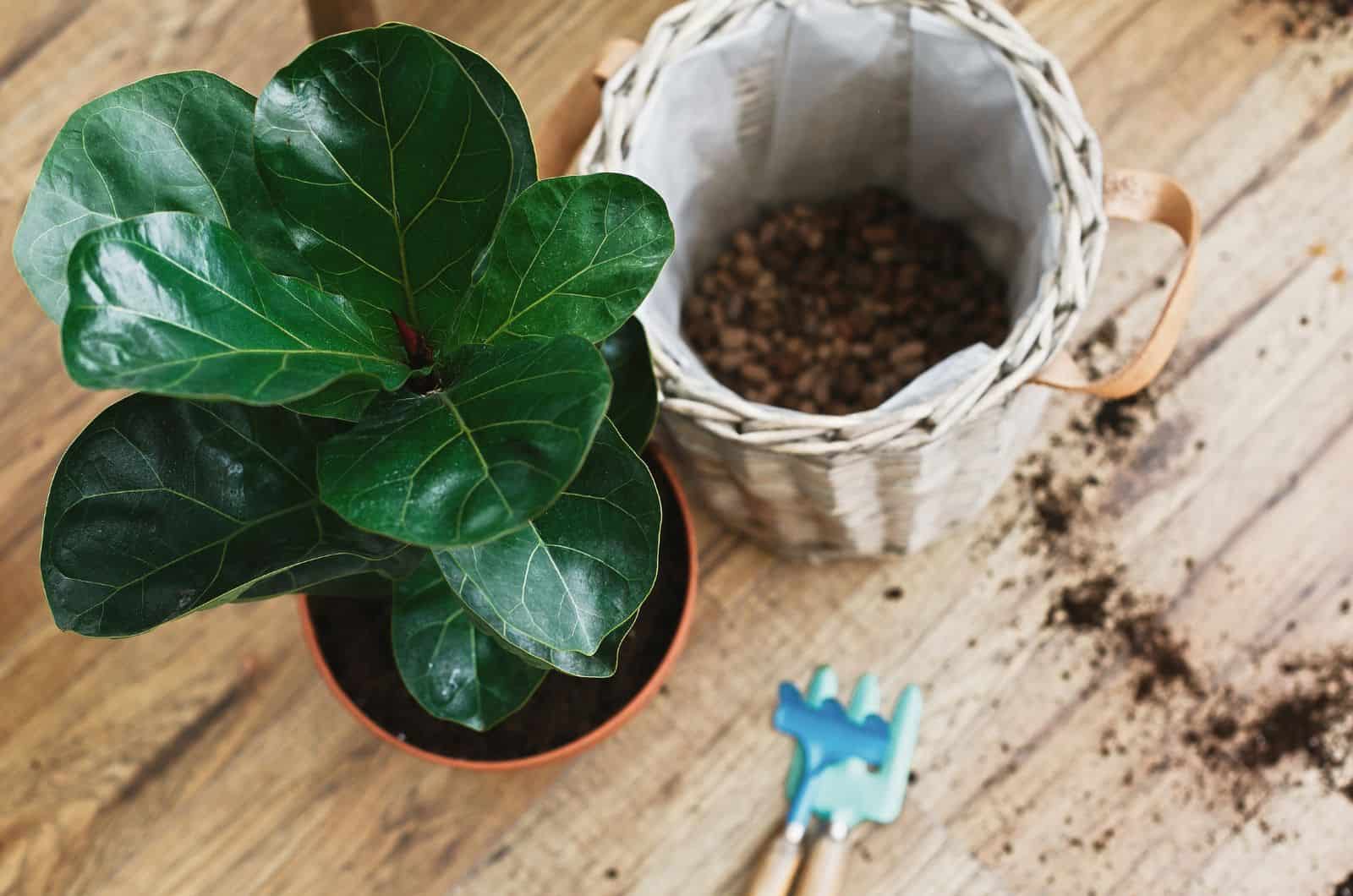I’ve always been intrigued about the fact that trees look amazing when grown indoors. Luckily, some trees have adapted well to indoor conditions and make perfect houseplants.
One such tree is the fiddle leaf fig, scientifically known as Ficus lyrata. The massive oval-shaped leaves, with stunning accentuated veins, make this plant a perfect focal point of any home.
Although it’s not hard to maintain these plants, we can sometimes make mistakes that can result in severe problems.
We make most of these mistakes with their watering, so, in this article, I’ll tell you more about an overwatered fiddle leaf fig.
First, it’s essential to know how to recognize the issue and how to differentiate an overwatered from an underwatered fiddle leaf fig.
After you’ve determined that your ficus lyrata has had too much water in its soil for an extended period, you need to start saving your plant.
Don’t worry; I’ll show you what you can do and how to water these plants so that the issue doesn’t occur again.
Let’s get started!
Signs Of An Overwatered Fiddle Leaf Fig
It may be hard to spot watering issues in the beginning, as the leaves are the first ones to suffer, and there are many other possible causes of this symptom.
But, an overwatered fiddle leaf fig will display root rot, leaf discoloration (browning or yellowing), leaves wilting, drooping, or curling, stunted growth, brown spots, and edema.
All of these signs have one thing in common—too much water in the soil as the cause!
Let’s get into the details!
Root Rot
Root rot is the most common problem of houseplants, and the fiddle leaf fig isn’t an exception. The biggest issue with this disease is that it’s hard to spot, as the roots aren’t visible because they are positioned underground.
However, a few things may tell you that your plant is suffering from this disease.
Mushy Soil And A Foul Odor
The first thing is mushy soil with a foul odor. Although the smell of rot is unpleasant (disgusting may be a better word), it may be useful in this situation as it is an obvious indication that something bad is happening beneath the soil’s surface.
Examine the soil carefully if you think your fiddle leaf fig tree is overwatered. There is too much water in the soil if it seems mushy and emits a foul odor.
The bad smell is caused by stagnant water; in this situation, your banjo fig needs more monitoring.
Moldy Soil
The most common sign of Ficus lyrata root rot is moldy soil. It is most likely a consequence of a fungal infection below the topsoil, so if you observe that the soil surface is covered in a powdery substance, you need to inspect the root system.
The problem is that if you continue adding more water to already saturated soil, you’ll provide more food for the fungi. As a result, the fungus will affect the entire root system.
Root Discoloration
If the soil is mushy and has mold on its surface, you’ll need to take your banjo fig out of its pot.
Of course, you need to know what healthy roots look like. The healthy roots of all plants should be light in color, usually greyish white. Additionally, they are firm to touch and won’t break as soon as you touch them.
On the other hand, unhealthy or rotting roots will be different in color but also in structure. If the roots receive too much water, they’ll turn dark brown or black. They’ll also be mushy, and some will fall off as soon as you touch them.
Leaves Turning Brown And Displaying Brown Spots
There are numerous frequent causes of brown dots on fiddle leaf fig leaves. Brown spots can result from fungi, insects, low humidity, and intense sunlight.
However, if you notice these kinds of patches, I strongly advise evaluating the soil’s moisture content first.
The question is, “Why do these spots appear?” Like in root rot, excess water in the soil is responsible for this issue.
What happens here is that the excess water causes the plant cells to drown, and the consequence is blister development on the leaves.
After the blisters occur, they’ll form brown lesions; according to science, your fiddle leaf fig plant is experiencing leaf edema, which typically affects the leaf undersides.
But, the browning may also occur in the center of the leaves.
Leaves Wilting And Dropping
If your fiddle fig plant starts to wilt from excess water, it will be close to dying. If the soil lacks water and you are dealing with an underwatered fig, you’ll just need to water the plant more often until it recovers.
But, that’s not the case with overwatering; too much moisture in the soil won’t stop causing trouble, and even if you leave the soil to dry, you will still be dealing with rotten roots.
The plant roots will have sustained so much damage that they won’t be able to meet the fiddle leaf fig’s needs for food and water.
Leaf drop and brown leaves will also occur due to nutrient deficiency.
Leaves Turning Yellow
There are several reasons why the banjo fig has yellow leaves. You can tell if overwatering is to blame for the yellowing by looking at the age and placement of the leaves.
The older lower leaves nearest to the soil should be examined. The bottom leaves of the pothos should be the first to get food and water from the roots.
If the roots stop working, they are unable to send food and water, and the leaves begin to yellow.
This process is commonly referred to as leaf chlorosis and necrosis.
Leaves Curling
The reasons why fiddle leaf fig leaves curl are likewise, rather varied.
Although you might assume that lack of water is the most typical symptom, an overwatered fig can also show this sign.
In both situations, the leaves become dehydrated; if underwatering is the culprit, the soil and fig’s roots are unable to supply the leaves with enough water.
On the contrary, excessive water will prevent the banjo fig’s roots from performing their main function. If they are dead, they will be unable to supply water to the leaves.
It has to be mentioned that the direction of the curling may help you to determine if your fig has too much or lacks water.
If too much water is in the fig’s soil, the leaves are most likely to curl downwards.
What the leaves are in fact doing, is reducing their surface so that they spare water and stop transpiration from occurring.
Banjo fig plants will make every effort to store water if the drought continues.
Stunted Growth
Ficus lyrata plants are known for their fast growth rate if provided with the necessary conditions. They’ll keep producing new leaves every month, which is a sign of healthy growth.
But, stunted growth is a tell-tale sign of overwatering.
If your banjo fig doesn’t display new growth during the growing season and shows some of the signs above, you’ll need to check on the plant further.
Overwatered vs Underwatered Fiddle Leaf Fig
It’s essential to know the differences between overwatered and underwatered fiddle leaf fig plants because the signs are very similar.
The problem is that you may think you are dealing with a lack of water and start watering your fig more often. You may be killing your plant if it already has too much soil moisture.
If your banjo fig lacks water, it will display brown spots, usually on the edges of the leaves. Eventually, you’ll notice that the entire surface of the leaves is brown.
One more sure sign of a lack of water is the curling of the leaves. I mentioned that the leaves would curl downwards if the soil had too much water in it. In a case of underwatering, the leaves will most likely to turn inwards.
Too much moisture in the soil will cause the lower leaves to drop, but if all the leaves are dropping, your fig lacks water.
The color and structure of the topsoil may also tell you more about the soil moisture content. If the color is light, the soil is dry to the touch, and there’s some space between the edges of the pot and the soil, you’ll need to water your plant more frequently.
If the plant lacks water for an extended period, it will wilt, and therefore, it will be way harder to save it.
How To Save An Overwatered Fiddle Leaf Fig
If you have determined that your fiddle leaf fig is overwatered, there are a couple of ways to save it. Of course, it is best to react as soon as the first sign occurs, but that may be pretty challenging to recognize.
So, what you need to do first is to determine how severe the issue is. The overall appearance of the plant will tell you if you are dealing with an almost dead plant.
I highly recommend repotting your fiddle leaf fig no matter the damage. You’ll also need to remove its rotten roots and prune off any discolored or diseased leaves. You’ll need to adjust other conditions that contribute to watering issues, such as light level and temperature. Finally, you’ll need to change your watering habits so the issue doesn’t occur again.
Repot Your Ficus Lyrata And Remove Root Rot
Repotting a fiddle leaf fig isn’t too challenging if you follow each step carefully. You’ll need to prepare some tools for houseplants, a special place for repotting, and a trash bin for the disposal of the rotten parts.
I also recommend calling your friend to help you, as a mature FLF may be too heavy to handle by yourself.
What Do You Need Before You Start Repotting?
When it comes to the equipment needed for repotting, you’ll need a sharp and sterilized pair of shears, fungicide, a new pot, a new potting mix, and gloves.
A well-draining and well-aerated potting mix are essential for fiddle leaf fig healthy growth. You can use a regular potting soil with some perlite, bark, or vermiculite added. A succulent mix also works well for these trees.
When it comes to the pot, make sure it’s of appropriate size and material. Choose terracotta or plastic pots over ceramic ones.
Now, let’s start repotting!
How To Remove Root Rot
Before you do anything else, you need to remove your fiddle leaf fig from its pot. Although this step seems easy, trust me, this is where you can damage the plant most.
Remember, your plant is weak at this point, so you need to be extra careful not to damage the healthy parts of the FLF plant.
Don’t pull the plant; lean the pot to one side and let your banjo fig slide out.
The root ball should be completely visible; therefore, you need to get rid of the soil that surrounds it.
Again, be very careful; you can use a soft brush or your hands.
Now, carefully inspect the root ball and look for mushy and discolored roots. Also, see how many healthy roots are left. Unfortunately, you’ll need to dispose of the plant if there are no healthy roots. If there are some healthy stem cuttings on the plant, you can propagate fiddle leaf fig cuttings in water.
Dip your shears in rubbing alcohol or bleach and start cutting off the root rot. Please sanitize the shears before each cut to minimize the chances of spreading the disease.
After you are done with cutting and only the healthy fiddle leaf fig roots are left, spray the fungicide over the entire root system.
Please discard the rotten roots in the trash bin and don’t add them to your compost pile if you have one.
Put The Plant In A New Pot
After the root ball is clean and the root system is disinfected, it’s time to place your fiddle leaf fig in the new pot. When purchasing containers for houseplants, remember that there should be drainage holes at the bottom of the pot, as all plants are susceptible to root rot.
First, fill about half of the pot with fresh soil. Take the plant, carefully place it on the potting mix, and add more soil so that your banjo fig stands firm.
Water your FLF and find an appropriate place to put it.
Prune The Affected Leaves
It’s not a good idea to leave severely damaged leaves on the FLF plant because they will no longer be functioning.
Although affected leaves aren’t fully healthy, they will continue to use food, which means that the healthy leaves won’t have enough water and food to keep growing.
These leaves will eventually begin to rot themselves; it’s just a matter of time. Find any yellow or brown leaves, then cut them off using a clean pair of shears.
After removing the damaged or dead leaves, you should wait a few days to check for any indications of recovery.
Change Watering Habits
Of course, to avoid any watering issues, you’ll need to change your watering habits in terms of finding a perfect watering schedule and technique.
Keep reading to find out how and when to water fiddle leaf figs, the amount of water they need, and what type of water to use.
Adjust Light
You also need to check/change the other plant care conditions if you want to create a perfect watering schedule.
First, you need to ensure adequate light levels. The larger amount of light your plant receives, the more water it will need, due to the faster transpiration rate.
But, bear in mind that FLF despises direct sunlight as it affects not only the watering schedule but also causes damage to the leaves.
Low light will prevent water from transpiring, meaning that there will be too much water in the soil. As a result, plants become prone to bacterial infections.
So, ensure bright indirect light by placing the plant near east- or west-facing windows. You’ll know that your FLF is receiving enough light if the leaves are glossy, the plant grows pretty quickly, and there are no sunburns or yellowing leaves.
Adjust Temperatures & Humidity
Indoor plants frequently have issues with temperature and humidity as these conditions also affect the watering schedule.
Banjo figs don’t respond well to lower temperatures; it causes the soil to lose water slower, resulting in overwatering. The ideal temperatures for this type of plant range from 65 to 75 degrees Fahrenheit.
Although these plants respond well to different humidity levels, you’ll need to pay more attention if you live in dry climates. You can mist your FLF regularly to keep the leaves well-moisturized.
All About Watering A Fiddle Leaf Fig
Now that we know how many issues inappropriate watering can cause, it’s time to learn about the perfect schedule, technique, and type of water for FLF plants.
Let’s find out everything!
When To Water
The essential thing to know about watering is that you should never rely on a fixed timetable.
This is due to the fact that higher temperatures, low humidity, and more light hasten the water evaporation from the potting mix.
The best course of action is to inspect the soil before each watering because completely dry soil will also cause issues.
For example, you’ll need to water your fiddle leaf fig more frequently during the hot summer and less during dormancy.
But again, check the moisture in the soil. The best option is to use a moisture meter before each watering as it will precisely tell you if your FLF lacks or needs more water.
This device is reliable and accurate and can be easily found on Amazon.
You can also determine if it’s time for watering by inserting your finger or a wooden stick into the soil or checking the color of the topsoil. If it’s dark brown, you might want to delay watering.
Watering Techniques
There are a few rules concerning the way you water your fiddle leaf fig. First, you need to use a watering can with a long neck, as it’s easier to control water flow with these.
Second, you should never water the fiddle leaf fig leaves, only add water over the topsoil.
Also, don’t spare water when watering; give your banjo fig a good soak, as light watering may lead to complications.
Type Of Water
Believe it or not, houseplants require a specific type of water.
For example, you should avoid using tap water for your indoor plants as it may contain pollutants such as fluoride and chlorine. This type of water may also contain salt and minerals that are harmful to FLF roots.
The ideal water to use on your fiddle leaf fig plant is rainwater that has been collected because it resembles the water in the plant’s natural environment.
If you can’t use rainwater, you can go with distilled or filtered water as the concentration of harmful pollutants is lower than in tap water.
Common Mistakes When Watering
Since you’ve now discovered how simple it is to overwater fiddle leaf fig, I don’t even need to tell you how important its drainage is.
The most common mistake of novice growers is not ensuring enough drainage for their houseplants.
There are two easy ways to fix this problem. First, the type of pot you use for your fiddle leaf fig may help you to ensure better drainage. As mentioned, always purchase pots that have drainage holes on the bottom.
The second way to boost the drainage is by using potting mix that contains well-draining materials; perlite, pumice, bark, or similar materials will prevent excess water from pooling in the soil.
We are often not consistent with watering, and we either wait too long between waterings, or we water too frequently. Unfortunately, both are wrong and may cause severe issues to your fiddle leaf fig.
Therefore, good drainage and consistency are the two essential things that can help you to create a perfect watering schedule.
Don’t forget to inspect your fiddle leaf fig regularly. Not only will this help you with its watering, but it will also help you to spot pests or diseases on time.
Even though the leaves look better when some water drops are on them, please don’t do this; the roots are the ones that need water, and they’ll make sure the leaves receive water. So, only water the topsoil!
Wrapping Up
Watering issues aren’t uncommon, especially for beginner growers. It may be pretty challenging to determine if and when plants need water.
An overwatered fiddle leaf fig will display leaves that are discolored, wilting, dropping, curling, and browning. Most of these signs are related to root rot.
So, if you spot any of these signs, start saving your fiddle leaf fig, as root rot is lethal to plants, and the fungi that cause it spread quickly.
I’m sure you’ll solve any issues by using our advice, but make sure to take good care of your fiddle leaf fig afterward.
Good luck and until next time!
Like this post? Share or pin it for later!


